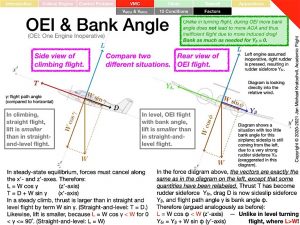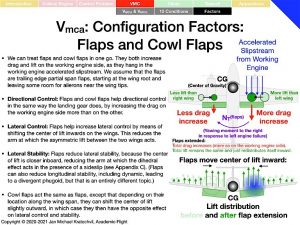Test-Pilot-School-Textbook-Based
Accelerated Multi Engine Training
3-Day Multi Engine Add-On Course
Duration
- 3 days of training,
- FAA Practical Test on 4th day,
- 7 hours of flight training in Piper PA-34-200 Seneca included,
- Airplane rental for multi engine checkride included (2 hours).
Special Features
- 8 hours of CFI access on each of your 3 training days,
- Industrial-strength ground school based on FAA publications and the textbooks of the USAF and US Naval Test Pilot Schools.
Price
$4590
Accelerated Multi Engine Training Materials
Below are a few sample slides from our multi engine ground school which is included with this course. If you follow the button below the slides, you will get to a page with further information and more samples.
Note:
This is a multi engine add-on course to an existing pilot certificate level (commercial or private). If you do not have your commercial pilot certificate yet, and would like to obtain it directly in a multi engine airplane, please see our different course here.
Course Details and Philosophy
This is the expanded version of the above summary (optional reading, you are encouraged to call us instead).
Training Times Included
- Course Duration:
3 days of accelerated multi engine training, plus one day for FAA Practical Test (typically with an additional day as potential weather backup for the test, at the examiner’s discretion). - Multi Engine Flight Training:
7 hours of multi engine flight instruction in a Piper PA-34-200 Seneca. - FAA Practical Test:
Multi engine airplane rental for the practical test is included in the course price (for up to two hours). The examiner fee of $700 is not included. - Ground Instruction:
17 hours of ground instruction (review of multi engine theory, oral exam preparation) is included on the above 3 training days. (In total you will have access to your flight instructor for 8 hours per day for ground and multi engine flight instruction.
Multi Engine Course Cost
Course Cost: $4590
Includes everything listed on the left. Total course cost listed is an estimate predicated on those times.Additional Flight Training Time:
If additional flight training is needed for your accelerated multi engine rating beyond the hours listed on the left, the price is $350/hour for the Piper PA-34-200 Seneca and $60/hour for flight instruction.- Additional Ground Instruction:
If additional ground instruction is needed, it is billed at $60/hour.
Accelerated Multi Engine Training Time Table
Day 1
- Morning:
Verification on the ground that you know all the multi engine maneuver procedures (and an opportunity to tie up loose ends); rehearsal of multi engine emergency procedures. - Afternoon:
1.5-hour upper airwork flight with instrument approach and 3 landings. Evening:
Ground instruction (review of multi engine theory) as needed.
Day 2
Morning:
1.5 hours of multi engine training, consisting of an upper airwork flight with instrument approach and 3 landings.Afternoon:
1.5-hour upper airwork flight with instrument approach and 3 landings.Evening:
Ground instruction for oral of FAA practical test.
Day 3
Morning:
1.5-hour upper airwork flight with instrument approach and 3 landings.Afternoon:
1 hour of flight training: landing practice (or 2 instrument approaches, whichever needs more work).Evening:
Ground instruction (final checkride preparation).
Day 4
- Morning or afternoon:
Multi engine rating FAA Practical Test. This concludes your accelerated multi engine training.
Weather Issues
If the weather is not conducive to flight on one of the days of your accelerated multi engine add-on course, the flying will be compressed into two days, and your multi engine instructor will use the bad weather day for ground instruction and multi engine procedure and instrument practice. If the weather prevents flight training on two days, the practical test will have to be postponed. To safeguard against this, you may elect to arrive one or two days early for your accelerated multi engine training if the weather forecast is questionable. If the weather is bad on the date of your practical test, the examiner often has a weather backup date the next day (while we try to arrange this, ultimately but this is up to the examiner though).
Candidate Preparation and Proficiency
This is an accelerated course, and you need to come well prepared. Accelerated multi engine training is demanding. How well you need to prepare, before arriving at our facility, is outlined below. There are three components of preparedness:
Theoretical Knowledge
The accelerated multi engine training program in this course is very doable for the price advertised. Your flight instructor has gone through an accelerated flight training course like this himself originally. But you must prepare at home ahead of time with the flight training materials which we will send you in advance. This includes going through the POH of the multi engine airplane. You will receive two 1-hour video conferences from us to help you with this preparation.
During the course we will review all the ground school materials twice: The first time the instructor will remind you of the content and explain anything that may have been unclear during your home study (you must understand after this one explanation). The second time you will present the material to the instructor in a mock oral setting. Unfortunately, there will be no time to go through everything twice a day because either you do not understand or do not remember – unless you are willing to incur additional training time. Furthermore, ideally we would like to take you beyond just the necessary basics for the practical test, so the better prepared you come, the more additional information we can impart on you, which is really one of our training objectives.
Airmanship
During accelerated flight training there is no time to get you “back into it”. You must be very proficient at airplane flying in general, as you arrive for your accelerated multi engine course. If you have not flown in the last three months, either get some practice before the course (you can do this with us if you like) or take our regular multi add-on course (and expect more flight training time). Having some prior flight experience in a single-engine complex airplane is an asset.
On your first training flight of this multi engine course you will be asked to go through all the practical test maneuvers one by one, and you must already know all the multi engine procedures for them and execute them without being prompted for the individual steps. The training flights are intended to give you practice to execute the maneuvers within ACS standards (in terms of altitude, heading, bank angle, and airspeed tolerance), not to teach you how to perform the maneuvers in principle. Each maneuver will be flown once on each flight, with the option of practicing a few of the weaker maneuvers a second time if needed; after that, we must move on to the next maneuver (you will get a chance to practice each maneuver on the next flight again).
Instrument Flight
You must be proficient at instrument flight, because you will be required to fly a one-engine-inoperative instrument approach on your multi engine practical test. Whether you are formally current and/or had a recent IPC is immaterial; some people successfully prepare with the flight simulator on their home computer. All you need is to be proficient at instrument approaches – IFR clearances and departure/en route procedures are not required.
Each of your upper airwork training flights during your accelerated multi engine course will end in an instrument approach. While we can do a couple of hours of simulator work to get you used to the avionics layout, in the multi engine airplane you will get to fly 4 instrument approaches during the course: generally two LPV (GPS) precision approaches and two VOR approaches (though we recommend you nail the VOR the first time and get yourself a third LPV instead). A fifth instrument approach may be doable if you are good at landings and want to do one instead of the landing practice flight. Any more practice will likely require extra multi engine airplane rental and flight time.
Accelerated Multi Engine Training Summary
Unless you have studied all the training materials diligently beforehand and come exquisitely prepared, you will need more multi engine flight time (and more ground instruction as well). If you cannot achieve this level of preparedness on your own for this accelerated multi engine add-on course, we recommend you book our regular Multi Engine Add-On Course instead, which lasts two days longer and where your multi engine instructor will teach you everything.
We do not promise you will finish in the flight time advertised; we merely provide you with an environment where you can, if you apply yourself, as other accelerated multi engine rating candidates have done before you, and we make it our personal goal to assist you as much as possible.
Multi Engine Training Materials and References
When you register for your accelerated multi engine training course, we will send you our own proprietary training material package, which we will kindly ask you to study before arrival. Below we provide links to some useful multi engine references published by the FAA and by test pilot schools (the latter are optional for the avid multi engine student, your instructor will gladly discuss them with you).
FAA Publications: (mandatory for course completion)
- “Airplane Flying Handbook,” FAA-H-8083-3B, U.S. Department of Transportation, Federal Aviation Administration, Flight Standards Service, Washington D.C., 2016, (Chapter 12: “Transition to Multiengine Airplanes”).
https://www.faa.gov/regulations_policies/handbooks_manuals/aviation/airplane_handbook/ - “Pilot’s Handbook of Aeronautical Knowledge,” FAA-H-8083-25B, U.S. Department of Transportation, Federal Aviation Administration, Flight Standards Service, Washington D.C., 2016.
https://www.faa.gov/regulations_policies/handbooks_manuals/aviation/phak/ - “Airman Certification Standards,” U.S. Department of Transportation, Federal Aviation Administration (FAA), Washington D.C.
https://www.faa.gov/training_testing/testing/acs/
Test Pilot School Textbooks: (optional, but recommended)
- USAF Test Pilot School, “Flying Qualities Textbook,” Volume II, Part 2, USAF-TPS-CUR-86-03, Edwards AFB, California, April 1986, (Chapter 11: “Engine-Out Theory and Flight Testing”).
http://www.dtic.mil/dtic/tr/fulltext/u2/a170960.pdf - “U.S. Naval Test Pilot School Flight Test Manual: Fixed Wing Stability and Control –Theory and Flight Test Technique,” USNTPS-FTM-No. 103, Naval Air Warfare Center, Aircraft Division, Patuxent River, Maryland, January 1997.
http://www.usntpsalumni.com/Resources/Documents/USNTPS_FTM_103.pdf





